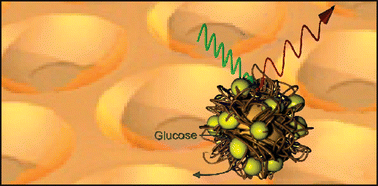We describe a general framework to design nanobiosensors based on a wired enzyme coupled to a redox molecule and integrated with SERS Au core–shell nanoparticles and ordered nanocavities. The response of the proposed sensor is based on the different electronic resonant Raman behavior of the oxidized or reduced electronic states of the molecular wire, and on the surface plasmon amplification induced by the tailored metallic substrate. The nanobiosensors can be interrogated remotely through the resonant Raman scattering intensity recovery or spectral variation of the redox molecule, an Os-complex, when the latter varies its oxidation state. Alternatively, we show through two-color spectro-electrochemistry that Raman scattering is also finely sensitive to oxidation state changes of flavin, a biomimetic system that mimics the active center of many flavoprotein enzymes. We show that multiple sample spectroscopic ellipsometry gives access to the spectral dependence of the optical constants of single redox-molecule layers, and through it to the electronic resonances of the system. All the components for selective molecular recognition and for the generation of an optical amplified signal, are self-contained in the proposed biosensor. As proof of concept a compact SERS sensor responsive to glucose with millimolar concentration in solution is demonstrated.

You have access to this article
 Please wait while we load your content...
Something went wrong. Try again?
Please wait while we load your content...
Something went wrong. Try again?


 Please wait while we load your content...
Please wait while we load your content...